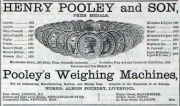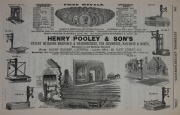









of Albion Foundry, Liverpool
of 72 John Bright Street, Birmingham. Telephone: Birmingham Midland 1737. Cables: "Pooley, Birmingham". (1929)
Pooleys were a firm of mechanical engineers, founded in Liverpool in the 18th century. Shown as Pooley of Liverpool in Heath Mill Lane, Birmingham.
c.1790 Business established by Henry Pooley senior, to make scale beams[1]
c.1830 Henry's son Henry Pooley was admitted to the firm as a partner
c.1835 They started to make platform scales. Their main office was at the Albion Foundry, Liverpool.
1835 Railway weighbridges were introduced by the firm.
Henry Pooley and Son was the biggest manufacturer of weighing machines in its time. They were often used in quarries to weigh rock.
Some machines were shipped to America during the Gold Rush.
1851 Award at the 1851 Great Exhibition. See details at 1851 Great Exhibition: Reports of the Juries: Class V.
1869 Advert. Weighing apparatus. Contractors for railway plant. general iron and tin plate merchants. [2]
1876 Mention that they are not exhibitors at the Royal Agricultural Show at Birmingham of their weighing equipment. [3]
1885 Gold medal for invention in respect of platform weighing machine and self-indicating apparatus, poly-graded steelyard, and automatic grain scale.
1894 June. Royal Agricultural Society's Show. Cattle weighbridge. [4]
1896 The main works were moved from Liverpool to Kidsgrove, Staffs., and the head office to Birmingham.[5]. "Mr. J. R. Chater, M.I.M.E., son of the chairman of Henry Pooley and Son, Ltd., was manager of the Kidsgrove engineering works, hitherto known as the Union Foundry, for the manufacture of weighing machinery. In future, the works will bear the name of the Albion Foundry, the designation of Messrs. Pooley’s works in Liverpool and Glasgow." [6].
1896 Advertisement for sale of equipment at Albion Foundry, including steam cranes and a 45-HP steam engine.[7]
1897 Company founded.
1900 The company was registered on 20 March, to take over the business of weighing machine manufacturers of a private company of similar title. [8]
c.1904 Acquired Hodgson and Stead Ltd
Works acquired in Smethwick for manufacture of smaller scales.
c.1912 Acquired Bartlett and Son Ltd, enabling the company to make a full range of scales and weighing machines[9]
1913 The company was absorbed by W. and T. Avery.[10]
1914 Private company.
1914 Manufacturers of weighbridges, weighing machines, scale beams, weights and shop fittings. Employees 1,500. [11]
1923 Patent - A new or improved means for electrically indicating and recording weighments.
1924 Patent - Improvements in and connected with printing or recording mechanism for weighing apparatus.
1929 Listed Exhibitor - British Industries Fair. Refers to Bartlett and Son Ltd. (See above) [12]
1935 See Henry Pooley and Son:1935 Review
1961 Manufacturers of weighing machines and scales. 330 employees. [13]
Weighing scales exhibit. [14]
Albion Foundry
The 1890 O.S. map[15] shows the irregularly-shaped foundry hemmed in by a variety of smaller buildings in a block surrounded by Dale Street, Manchester Street and Old Haymarket. Close by, with its entrance on the opposite side of Dale Street, was Dale Street Foundry
See Also
Sources of Information
- ↑ The Times (London, England), Wednesday, Oct 02, 1912
- ↑ 1869 Bradshaw’s Railway Manual
- ↑ The Engineer of 21st July 1876 p58
- ↑ The Engineer of 29th June 1894 p562
- ↑ The Times, Oct 2, 1912
- ↑ Bedfordshire Times and Independent, 24 October 1896
- ↑ Liverpool Mercury, 22 December 1896
- ↑ The Stock Exchange Year Book 1908
- ↑ The Times, Oct 02, 1912
- ↑ The Times, Feb 04, 1914
- ↑ 1914 Whitakers Red Book
- ↑ 1929 British Industries Fair Page 138
- ↑ 1961 Dun and Bradstreet KBE
- ↑ Museum of Country Life at Exmouth
- ↑ The Godfrey Edition Old Ordnance Survey Maps: Liverpool (North) 1890 Lancashire Sheet 106.10, '1893 Edition'








































